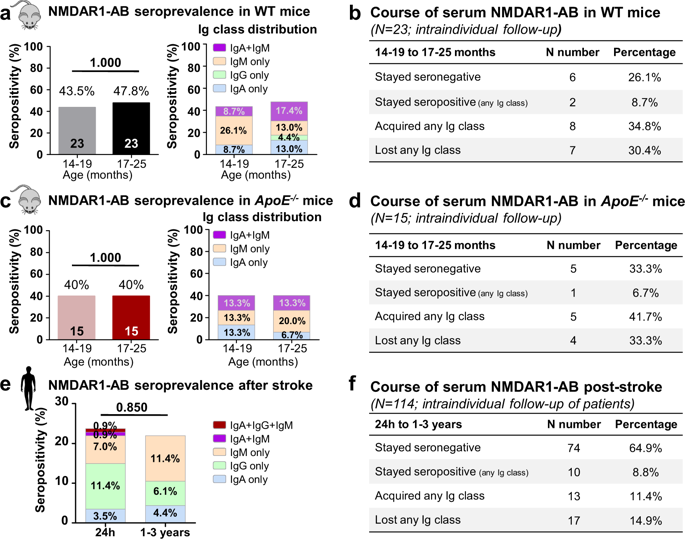当前位置:
X-MOL 学术
›
Mol. Psychiatry
›
论文详情
Our official English website, www.x-mol.net, welcomes your
feedback! (Note: you will need to create a separate account there.)
Multiple inducers and novel roles of autoantibodies against the obligatory NMDAR subunit NR1: a translational study from chronic life stress to brain injury.
Molecular Psychiatry ( IF 9.6 ) Pub Date : 2020-02-24 , DOI: 10.1038/s41380-020-0672-1 Hong Pan 1 , Agnes A Steixner-Kumar 1 , Anna Seelbach 1 , Nadine Deutsch 2 , Anja Ronnenberg 1 , Daniel Tapken 3 , Nico von Ahsen 4 , Marina Mitjans 1 , Hans Worthmann 2 , Ralf Trippe 3 , Christina Klein-Schmidt 3 , Nadine Schopf 1 , Kristin Rentzsch 5 , Martin Begemann 1, 6 , Jürgen Wienands 7 , Winfried Stöcker 5 , Karin Weissenborn 2 , Michael Hollmann 3 , Klaus-Armin Nave 8 , Fred Lühder 9 , Hannelore Ehrenreich 1
Molecular Psychiatry ( IF 9.6 ) Pub Date : 2020-02-24 , DOI: 10.1038/s41380-020-0672-1 Hong Pan 1 , Agnes A Steixner-Kumar 1 , Anna Seelbach 1 , Nadine Deutsch 2 , Anja Ronnenberg 1 , Daniel Tapken 3 , Nico von Ahsen 4 , Marina Mitjans 1 , Hans Worthmann 2 , Ralf Trippe 3 , Christina Klein-Schmidt 3 , Nadine Schopf 1 , Kristin Rentzsch 5 , Martin Begemann 1, 6 , Jürgen Wienands 7 , Winfried Stöcker 5 , Karin Weissenborn 2 , Michael Hollmann 3 , Klaus-Armin Nave 8 , Fred Lühder 9 , Hannelore Ehrenreich 1
Affiliation

|
Circulating autoantibodies (AB) of different immunoglobulin classes (IgM, IgA, and IgG), directed against the obligatory N-methyl-D-aspartate-receptor subunit NR1 (NMDAR1-AB), belong to the mammalian autoimmune repertoire, and appear with age-dependently high seroprevalence across health and disease. Upon access to the brain, they can exert NMDAR-antagonistic/ketamine-like actions. Still unanswered key questions, addressed here, are conditions of NMDAR1-AB formation/boosting, intraindividual persistence/course in serum over time, and (patho)physiological significance of NMDAR1-AB in modulating neuropsychiatric phenotypes. We demonstrate in a translational fashion from mouse to human that (1) serum NMDAR1-AB fluctuate upon long-term observation, independent of blood-brain barrier (BBB) perturbation; (2) a standardized small brain lesion in juvenile mice leads to increased NMDAR1-AB seroprevalence (IgM + IgG), together with enhanced Ig-class diversity; (3) CTLA4 (immune-checkpoint) genotypes, previously found associated with autoimmune disease, predispose to serum NMDAR1-AB in humans; (4) finally, pursuing our prior findings of an early increase in NMDAR1-AB seroprevalence in human migrants, which implicated chronic life stress as inducer, we independently replicate these results with prospectively recruited refugee minors. Most importantly, we here provide the first experimental evidence in mice of chronic life stress promoting serum NMDAR1-AB (IgA). Strikingly, stress-induced depressive-like behavior in mice and depression/anxiety in humans are reduced in NMDAR1-AB carriers with compromised BBB where NMDAR1-AB can readily reach the brain. To conclude, NMDAR1-AB may have a role as endogenous NMDAR antagonists, formed or boosted under various circumstances, ranging from genetic predisposition to, e.g., tumors, infection, brain injury, and stress, altogether increasing over lifetime, and exerting a spectrum of possible effects, also including beneficial functions.
中文翻译:

针对强制性 NMDAR 亚基 NR1 的自身抗体的多种诱导剂和新作用:从慢性生活压力到脑损伤的转化研究。
针对必需的 N-甲基-D-天冬氨酸受体亚基 NR1 (NMDAR1-AB) 的不同免疫球蛋白类别(IgM、IgA 和 IgG)的循环自身抗体 (AB) 属于哺乳动物自身免疫库,随着年龄的增长而出现- 健康和疾病的相关性高血清阳性率。进入大脑后,它们可以发挥 NMDAR 拮抗/氯胺酮样作用。此处解决的仍然未解决的关键问题是 NMDAR1-AB 形成/增强的条件,随着时间的推移在血清中的个体持续性/过程,以及 NMDAR1-AB 在调节神经精神表型中的(病理)生理意义。我们以一种从小鼠到人类的转化方式证明:(1)血清 NMDAR1-AB 在长期观察时波动,与血脑屏障 (BBB) 扰动无关;(2) 幼年小鼠标准化的小脑损伤导致 NMDAR1-AB 血清阳性率(IgM + IgG)增加,同时 Ig 类多样性增强;(3) CTLA4(免疫检查点)基因型,先前发现与自身免疫性疾病相关,在人类中易患血清 NMDAR1-AB;(4) 最后,根据我们先前关于人类移民中 NMDAR1-AB 血清阳性率早期增加的发现,这表明慢性生活压力是诱因,我们独立地用预期招募的未成年难民复制了这些结果。最重要的是,我们在这里提供了第一个在慢性生活压力促进血清 NMDAR1-AB (IgA) 的小鼠中的实验证据。引人注目的是,在 BBB 受损的 NMDAR1-AB 携带者中,小鼠的压力诱导的抑郁样行为和人类的抑郁/焦虑减少了,其中 NMDAR1-AB 可以很容易地到达大脑。
更新日期:2020-02-24
中文翻译:

针对强制性 NMDAR 亚基 NR1 的自身抗体的多种诱导剂和新作用:从慢性生活压力到脑损伤的转化研究。
针对必需的 N-甲基-D-天冬氨酸受体亚基 NR1 (NMDAR1-AB) 的不同免疫球蛋白类别(IgM、IgA 和 IgG)的循环自身抗体 (AB) 属于哺乳动物自身免疫库,随着年龄的增长而出现- 健康和疾病的相关性高血清阳性率。进入大脑后,它们可以发挥 NMDAR 拮抗/氯胺酮样作用。此处解决的仍然未解决的关键问题是 NMDAR1-AB 形成/增强的条件,随着时间的推移在血清中的个体持续性/过程,以及 NMDAR1-AB 在调节神经精神表型中的(病理)生理意义。我们以一种从小鼠到人类的转化方式证明:(1)血清 NMDAR1-AB 在长期观察时波动,与血脑屏障 (BBB) 扰动无关;(2) 幼年小鼠标准化的小脑损伤导致 NMDAR1-AB 血清阳性率(IgM + IgG)增加,同时 Ig 类多样性增强;(3) CTLA4(免疫检查点)基因型,先前发现与自身免疫性疾病相关,在人类中易患血清 NMDAR1-AB;(4) 最后,根据我们先前关于人类移民中 NMDAR1-AB 血清阳性率早期增加的发现,这表明慢性生活压力是诱因,我们独立地用预期招募的未成年难民复制了这些结果。最重要的是,我们在这里提供了第一个在慢性生活压力促进血清 NMDAR1-AB (IgA) 的小鼠中的实验证据。引人注目的是,在 BBB 受损的 NMDAR1-AB 携带者中,小鼠的压力诱导的抑郁样行为和人类的抑郁/焦虑减少了,其中 NMDAR1-AB 可以很容易地到达大脑。










































 京公网安备 11010802027423号
京公网安备 11010802027423号